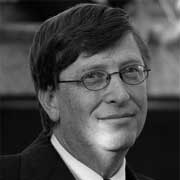

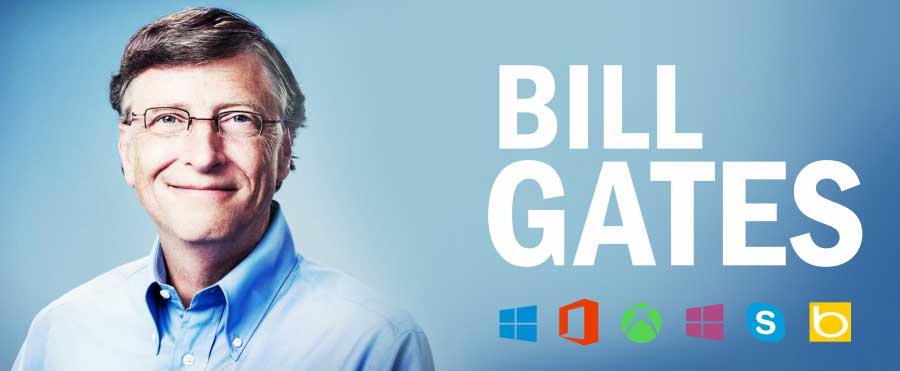
Bill Gates
Hello? Hello? […clearing throat] anybody there? It’s all dark in here. Are you wondering why it is all dark in here? Well, we are in a room that has no windows and to top it there is a power failure. [Clap! Clap!] Lights please! [Clap Clap!] Windows Please!
Oh my God!! It is just impossible to live in a room with no windows. Well, imagine a world without Windows! Yes, the Windows Operating System. Right from logging into a computer at work, to connecting the web via Internet Explorer, or using the MS-Word to draft correspondences, prepare Power Point presentations for clients, or getting your account statements on an Excel sheet, today we are so dependent on these tools to perform our daily tasks that we just cannot imagine a single day, forget a day, not even an hour without the Windows.
All this was not the case two decades ago and the one person who streamlined our work process is the man who had the vision of a computer on every desk. The one name that has gone down in history to be one of the most influential persons of our times is none other than Mr. Bill Gates.
William Henry Gates III popularly known as Bill Gates co-founded one of the biggest software companies of the world with his friend Paul Allen. The company which today we recognize by the name “Microsoft” and which was initially called “Micro-Soft.”
In his speech at the Harvard University graduation ceremony, Bill Gates said, “Humanity’s greatest advances are not in its discoveries, but in how those discoveries are applied to reduce inequity.” He was the man who opened the “Windows” to the personal computer revolution, whose contributions shaped the lifestyle of people transiting from the second millennium to the third.
In a single window Bill Gates can be described as: one of the richest men in the world, computer programmer, chief software architect, entrepreneur, author and a philanthropist. You click the icon Bill Gates and it will take you through the journey of the most influential person of this time.

click start


After serving the U.S. army in World War II, Bill Gates’ father William Gates II studied law at the University of Washington. Here, he met his life partner Mary Maxwell. The couple got married in 1951 and raised their kids in Seattle. William worked with a law firm while Mary was into teaching which she later gave up to raise kids. The Gates household was now abuzz with its first born, while cosmic miles away a nebula named Bill Gates was racing to hit earth and was finally born on 28 October, 1955, in Seattle, Washington. Bill Gates was the fourth member in the Gates family tree with the similar name – William Gates. His father’s name carried the suffix II and as a result, Bill Gates’ name got the suffix III at the end of his last name.
In the operating system lingo, it can be said that inside the folder name Gates, you have the folder William & Mary and inside that folder there are three files – Kristianne, Bill and Libby. Kristianne was the eldest child of the family, Libby the youngest and Bill was the brother to these girls. The Gates were regulars at the Congregational Church.
The Gates siblings had a great upbringing, in fact, in Bill’s words it was a rich environment to learn. In childhood, Bill played cards, board games and jigsaw puzzles instead of watching television. His favourite games were Risk and Monopoly. He learnt to play cards from his mother and grandmother. And right from the start, he loved to rock in the cradle, on the toy-horse and even while he read. Bill believed that by rocking in the sitting position the mind seemed to work better and it helped in concentration.

school life

In his early years, Bill showed great interest in subjects like Maths and Science. His teachers say that he had a wide sense of interests and was also a good dramatist. Reading was something Bill loved to do right from childhood. He was only 8 years old when he began reading The World Book Encyclopaedia. He had decided that he would read the entire set through every volume, but he could only manage reading it up to the letter P as he got busy with other activities. In another instance, the pastor of the Congregational Church that the Gates used to go to recalls, how a young Bill had memorized three chapters of the Bible and that too, with a deep understanding of the words.
Did you know?
When Bill was in school, he would write with both left and right hand. For most of the times, he was a left hander, but when he got bored, he would challenge himself by writing right-handedly.
Bill had interesting nicknames: “Little Bill”; his maternal grandmother whom he fondly called Gam, nicknamed him “Trey” and had the suffix III attached to it. According to the favourite past time of the family, card playing, Trey was the term used to call out for the card three, thus Gam would call him Trey.
Bill was in fourth grade when the family moved to a new house in Seattle. And the ten year old Trey was already getting bored with school life. However, he was a clever student and would score the highest grades in the class. Among the extra-curricular activities, he found team sports boring and as a matter of fact he tried playing baseball, but found it too slow. Instead, he enjoyed skiing, playing tennis and sailing. He was more inclined towards adventurous activities such as hiking and camping trips.
Up to the age of twelve, Bill studied in a public school. As a sixth grader, he seemed to be lacking focus. It was during this time that he joined the Century Club- a club made up of smart sixth graders. Bill would go out with the club members on educational field trips and also play board games with them. With a gifted son like Bill – a topper in the class and an avid reader – his parents thought that they should move him to a private school. They wanted to prepare their son for college education and thus Bill was moved to an exclusive preparatory school – The Lakeside School.
Bill was the youngest among his seventh grade classmates. His parents were worried as to how would their little Bill adapt with the new setting, mainly because he was small and shy. The first year in junior high did not start with a bang. Bill did not work hard on his studies; he got grade B in all the subjects except for honours algebra in which he got the grade ‘A minus’. He got along well with students who were interested in Maths and Science. The one habit since childhood that he carries forward till date is reading. Currently, he reads the ‘TIME’, ‘The Wall Street Journal’ and ‘The Economist’ to stay abreast and to learn new things. Back then in school days, he liked reading biographies. His favourite biographies were that of the French emperor Napoleon Bonaparte and Franklin D. Roosevelt.
Aldous Huxley, the famous writer once said, “Every man who knows how to read has it in his power to magnify himself, to make life full, significant and interesting.” One of the few men who exemplify this quote is Bill Gates.
Around late 1960s, the personal computer was not invented as yet, and it was only the ‘Mainframe computers’ that were used for businesses and universities. As these computers costed millions of dollars, the practice was that the universities, in an arrangement with businesses, would share a single computer. At Lakeside School, the school had an arrangement with the local General Electric office. Thus, Bill and his friends were lucky enough to have hands on their school’s Teletype machine.
How did the Teletype work?
The Teletype machine had a keyboard, a printer, a paper-tape punch and reader. This machine was connected to the Mainframe via telephone. The operator had to punch instructions to the computer which were called programs and were then sent through telephone lines.
The arrangement that was worked out between the Lakeside School and General Electric was something like this: the students had to pay a monthly fee of 89 dollars and an hourly fee of 8 dollars to use the Teletype. Back then in 1968, 89 dollars as per today’s exchange rate amounted to say approximately four thousand rupees a month and this was definitely not a small amount. The Lakeside Mother’s Club helped their kids to pay the bills through a yearly garage sale. As far as Bill’s parents were concerned, they paid for his tuition fees and books but wanted Bill to manage his computer fees.Now, computer was something new for the students and even the teachers were also unsure about writing programs to instruct the computer. Amazingly, in such a scenario young Bill referred to the handbook and soon learnt that if instructed and programmed properly, this machine could solve mathematical problems. 13 year old Bill found the machine very interesting and along with his friends, he would spend a lot of time on the computer. It was at Lakeside School that Bill Gates met Paul Allen. Bill along with Paul and other friends formed the ‘Lakeside Programmers Club’. Bill was so fascinated by the computer that he would wake up in the night and go to work on it. At age of just 13, Bill was turning out to be a master in computer and he wrote his first program which was for playing tic-tac-toe. The newly found focus and zeal got him an A grade in the ninth standard. He scored an A in Maths too without attending even a single class. By scoring an A and writing the first software program Bill was now on a roll.The game tic-tac-toe was just the start and later Bill also wrote a program to play the game ‘Risk’. It was one of the board games he had played when he was a little boy. He would spend long hours together on the computer about which his classmates would later complain. But, when they would be stuck while running a program, they would approach Bill only.The members of Lakeside Programmers Club would meet regularly and work on writing and running programs. The club got its buzz when it bagged the first business deal with a company called the ‘Computer Centre Corporation’, nicknamed ‘C-Cubed’. The job was to track down bugs in the software. The idea of making money out of a hobby was something thrilling for Bill and Allen. Bill was happy that he could make money this way as it helped him take care of his computer fees. He said in an interview, “The fact that I had to manage for the fees drove me to the commercial side of the software business.”
After this, the next job was a $5,000 project to write a payroll program to work out the weekly pay for their employees. One of the other projects that the club worked on was to write program to manage the daily traffic flow.
Now Bill was in his junior high third year, which is equivalent to class eleven. In this year, the Lakeside School merged with Saint Nicholas School which was a girl’s school. With this merging, came the need of re-scheduling classes for the students. The teachers were having a tough time in coming up with a schedule that would take care of the entire academics and curriculum for the year. So, they approached the boys – Bill and his friends. In those days, Bill was friends with Kent Evans and they spent long hours in writing a program to create a schedule as they had a deadline to meet. Here Bill and Evans were busy working on the schedule and there life had something else in store for them. Like always, tragedy came home uninvited. In a mountain climbing accident, Bill lost his dear friend Kent. The news came as a shock to Bill but he had to somehow cope with it as he had to submit the program. Finally, with the help of Paul Allen, Bill completed the task.
Another leaf turned, Bill entered the senior year, the equivalent of twelfth grade and got a new job as a programmer for TRW Inc. The company was into controlling an electricity grid and Bill’s job was to write a program to control the grid. Allen, who had graduated before Bill, was already working with this company. As Bill was by now working as a software programmer, his school allowed him to skip school and considered his job as his senior year project.
The kind of student life that Bill lived was unlike his other classmates. He slept at irregular hours and often worked for 36 hours at a stretch. He would frequently survive on pizzas and Coke and would be found asleep under his desk. Besides computers, he was active in dramatics and had starred in three plays. He played chess, did some water-skiing and drove his family’s Mustang convertible. Bill was smart and intelligent and to make the numbers speak for it, he scored almost maximum in his Scholastic Aptitude Test (SAT). He hit a perfect 800 in maths and a 700 in verbal; he scored a total of 1590 on 1600.Apparently, it is said that when Bill started dating he would ask his date how much did she score in SAT. With a score like this none of the universities refused Bill’s admission application, be it Harvard, Yale or Princeton. Bill was clear about what he wanted and he chose Harvard over the other two universities.
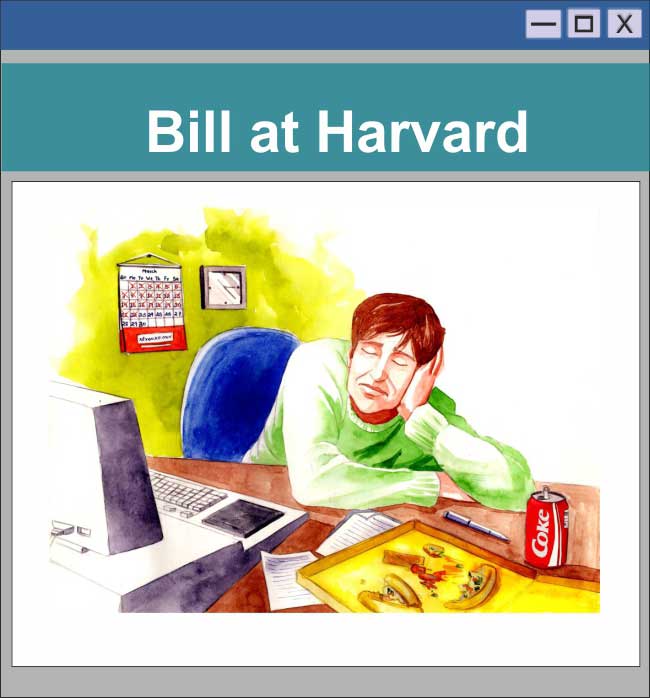
bill at harvard

With an entry into Harvard, the 18 year old Bill was now in a bigger league. At Harvard, he took classes in advanced Maths, Greek, Literature, English, Social Science and Organic Chemistry. He would spend most of his time at the computer centre. He was now writing programs for a computer baseball game. This required him to use complex mathematical formulae to calculate the actions of the figures in the game, actions such as throwing, hitting, running and catching. Bill was so much into programming that he even dreamt about computers and spoke about codes in his dream.
Bill was not totally “all work and no play” kind of a boy. He would go for movies and play poker all-night. He would hang out with maths students, go to hamburger restaurants and chat over varied topics. In one of these hangout instances during the sophomore year, Bill met Steve Ballmer, the man who later went ahead to become the CEO of Microsoft. Together, the duo took graduate-level courses in Maths and Economics.
If you remember, in the early days of the Lakeside Programmer Club, Bill and his friends worked on traffic control software. After a reasonable amount of programs and projects, Paul and Bill decided to take it to the next level. They planned to build a company together and create their own computer software. Around this time, they were working on a system ‘Traf-O-Data’ that could keep a count of the data and analyse the traffic pattern. However, the duo did not complete the project as Allen got a job at Boston and had to move.
Say more than 200 moons had passed, several diary leaves turned, and the December of 1974 was here. Bill was in his second year at Harvard and Allen came to visit him. While walking across the campus, something interesting caught Allen’s eye. The January issue of ‘Popular Electronics’ magazine on the newspaper kiosk absorbed his attention. The cover page read: “World’s First Minicomputer Kit to Rival Commercial Models… “ALTAIR 8800.” Allen used to regularly read the magazine ever since his Lakeside School days. The title of the cover page got him ecstatic and after reading the article he rushed to find Bill and share the excitement with him. For the first time a computer company had come out with a minicomputer. ‘Altair’ on the Popular Mechanic cover page looked like a box with rows of lights and buttons. It had no keyboard, no monitor or interactive format. The engineers would write programs on the chip and in response, the lights would blink.
The manufacturers of Altair, ‘Micros Instrumentation and Telemetry System (MITS)’ were based at Albuquerque, New Mexico. On learning about the first minicomputer, Bill was pretty excited and could not stop himself from calling the makers of Altair. He made a call to the Albuquerque office and told the person on the other end that he had written software for the minicomputer built by their company. They asked him to get back after five to six weeks. Bill was like, “okay great!!” He was relieved, as in reality, Bill had not even scratched the P of the program. In other words, he had not yet begun writing the software.
Day-in and day-out for the next six weeks, Bill was stationed at the Harvard computer centre. He would fall asleep over the keyboard or in the corner of the computer lab. In the early days of computer, there were two programming languages: ‘BASIC’ and ‘FORTRAN’. Apparently, FORTRAN was used by the scientists. While Bill was working on the project, Allen joined him after work. Besides themselves, they also hired many Harvard students to write small parts of the BASIC program.
Six weeks were gone and the program was almost ready. The only thing remaining was to run it on the Altair. Allen went to visit the officials at Altair and the program worked out just perfect in the first attempt itself. The duo named the program ‘MS-BASIC’. MS-BASIC worked as an interpreter on Altair. You could now instruct the computer by working on the MS-BASIC and the computer would give you the desired output. Henceforth, Altair was sold with a license copy of MS-BASIC.
The owner of MITS, Ed Roberts, was quite impressed with the program. He not only bought the program, but also offered Paul Allen the job of Director of Software. Paul’s next step after accepting the job was to move to Albuquerque while Bill returned to Harvard. The earth’s axis was now tilting and Bill could strongly sense that the domain of technology was going to change in a massive way. The minicomputer was soon becoming popular so the duo thought about starting a setup of our own.
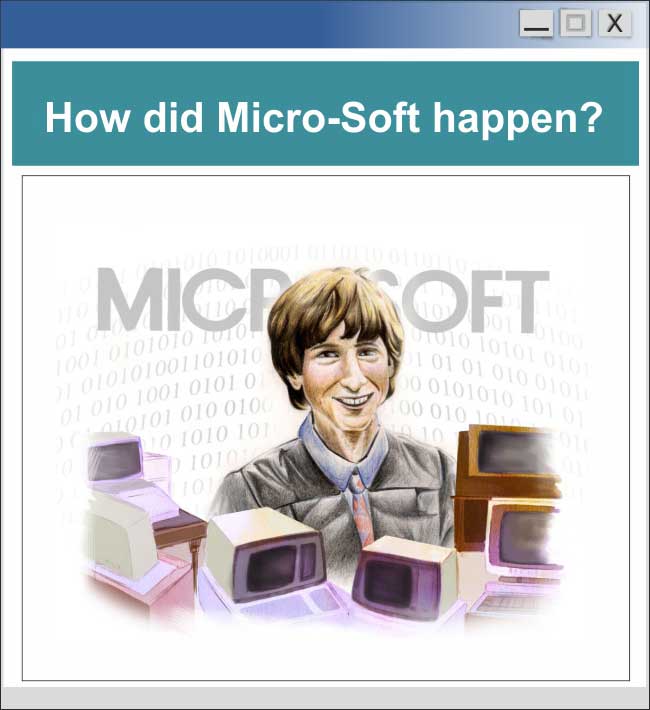
How did Micro-Soft happen?
It was the spring of 1975 and 20 year old Bill had finished his classes at Harvard. On the time graph of 1975, the two coordinates, Bill and Paul came together in the month of April and formed their own company and named it ‘Micro-Soft’. The office was located in Albuquerque, New Mexico. To commence the business, the 21 year old Paul quit his job at MITS and Bill quit Harvard. Bill’ mother was upset with his decision of leaving Harvard, but her son was clear about what he wanted and was sure about his next move. Bill knew that everything else in this world could wait but not this phenomenon that was going to take place in the history of mankind – the personal computer revolution. In time to come, his decision proved to be the best decision he ever took and he went ahead to become the Sultan-of-Software and the richest man in the world.
Bill did not sell the MS-BASIC program outright to Ed Roberts. Instead, he gave it on license or leasing agreement. According to this agreement, the first minicomputer Altair 8080 would come along with the software that Bill and Paul had created –MS-BASIC. Now, back then in those days, ideally, computer hackers would write programs and share it or give it away for free. But Bill for that matter did not appreciate such practice. When he learnt that a copy of his program was leaked and the computer hobbyists were copying and sharing it widely, he wrote an open Letter to them from the “Homebrew Computer Club” newsletter, in January 1976. He expressed his annoyance with the hackers who were stealing programs which according to Bill was infringement of intellectual property. In the exact words stated in the letter, he said: “As the majority of hobbyists must be aware, most of you steal your software. Hardware must be paid for, but software is something to share. Who cares if the people who worked on it get paid? Is this fair?...but those who have been reported to us may lose in the end.”
While all this was happening in the background, the idea of depending on MITS to sell Micro-Soft’s products was not seeming good enough to Paul and Bill, so they got back the rights to their software and started writing different versions of BASIC for various new computer companies entering the market such as ‘Apple’, ‘Commodore’ and ‘Texas Instruments’.
Micro-soft was now on a roll as more orders started coming in, and within a year its sales touched the $1 million mark. At the work front, it was not easy to have programmers move to Albuquerque, considering the rising demand for software and therefore, with only twelve employees on their payroll, Bill and Paul moved their company to Seattle in 1979. With this move, the hyphen between ‘Micro’ and ‘Soft’ was dropped and the company began to be known as ‘Microsoft’.
What Microsoft was cashing in on was the ripple effect in the computer industry as this period saw great demand for computers. Computers could take care of most office work needs, whether calculations, storing data or typing a document. Computer became a great utility product in business environment and later in personal environment as well. Microsoft’s word processing program was gaining popularity in the business circle as the users could now create and edit copies of documents and format their word document as per their requirements into paragraphs, font size and type.

START > MICROSOFT > IBM


It was around this time in 1980 that the ‘International Business Machine’ (IBM), the leader in mainframe computer business decided to enter the personal computer segment. IBM wanted to get into the market with personal computers at the earliest. They did not want to build a computer from scratch but rather assemble parts that were ready-to-use and for its software they approached Bill Gates. IBM was looking for an operating system for its computer. Bill Gates’ mother, Mary Gates was on the board of directors of a company called ‘United Way’. One of the members of the board of directors was the CEO of IBM, John Opel and thus it was through his mother that Bill came in touch with the bosses of IBM.
The IBM chapter was the first big chapter in the books of Microsoft. By now Bill was 25 years old and had 60 employees working for him. The big project at hand was to develop an operating system for IBM. Considering that Microsoft had to complete the project in less amount of time, Bill bought the rights to ‘QDOS’ (Quick and Dirty Operating System), also known as ‘86-DOS’ from ‘Seattle Computer Products’. He modified the QDOS and came up with a system that met IBM’s specifications. He named it MS-DOS. The entire staff of Microsoft worked hard day and night on the IBM project. The first edition of MS-DOS was launched in 1982.
The first offering of Microsoft was the MS-BASIC and now MS-DOS. Like MS-BASIC, Bill licensed MS-DOS to IBM and did not sell it outright to them. According to the agreement, IBM would pay a royalty fee to Microsoft on every personal computer that it would sell. During the same time, the IBM personal computers hit the market. Sensing the magnitude of the demand, many computer makers began to float the clones of IBM PC. Though building a clone PC was easy as assembling inexpensive parts was not such a hard job, but the real challenge was getting the software to run the unit. Microsoft now started selling their software to the clones as well as the branded computer makers. Thus, MS-DOS was everywhere.



Little before the year 1982 could draw the curtains, Microsoft registered a stunning figure of sales worth $24, 486,000 and just when it seemed like all wheels of Microsoft’s success were speeding high, a bolt got loose. Paul Allen was diagnosed with Hodgkin's disease. Bill was taken aback by the news, as it meant that Bill had to run Microsoft single handed now onwards. Paul was around for some time but he later resigned from his duties in 1983.
In the computer market, IBM and Apple Computers were leading from the front. Apparently, the driving force behind good sales was the utility quotient of a personal computer. That is, what all can I do with my computer? I can store, manage, work and share files and documents. What else?
Bill realized that the applications played an important role in taking the world of computers to the next level. Thus, he started working on three applications to begin with: ‘Microsoft Word’ (a word processing application), ‘Multiplan’ (an application that had spreadsheets which could be used for accounts), and lastly, an application for games.
On the timeline of computers, the first half of 1983 can be called the phase where the caterpillar was turning into a butterfly. The computer makers came out with ‘Graphic User Interface-centric’ (GUI) computer operating models which enabled you to see windows, menus, radio buttons, checkboxes and icons on the screen. It also came along with a pointing device called the mouse. By aligning Microsoft’s programs with GUI, Bill launched the Microsoft Word, an enhanced word processing application that was empowered by ‘WYSIWYG’ (What You See Is What You Get) design.



The baby steps of GUI turned into a leap when Apple launched ‘Macintosh’. The GUI had changed the face of computer. Now you had a colour screen that gave you menus to choose from and a mouse to move through the programs, and make choices.
Microsoft continued its relationship with IBM and it was now working on creating an operating system for IBM’s new powerful computer ‘IBM PC-AT’. During this project, there were creative differences between Bill and people at IBM over the functionalities of the product. Finally, IBM completed the product ‘OS/2’ and launched it in the market.
If IBM had thing its way, Bill too wasn’t far behind. The creative differences between them only worked as a boon for the computer industry as both the parties came out with their own separate version of the product. IBM came out with OS/2 and Bill Gates came out with ‘Windows’.

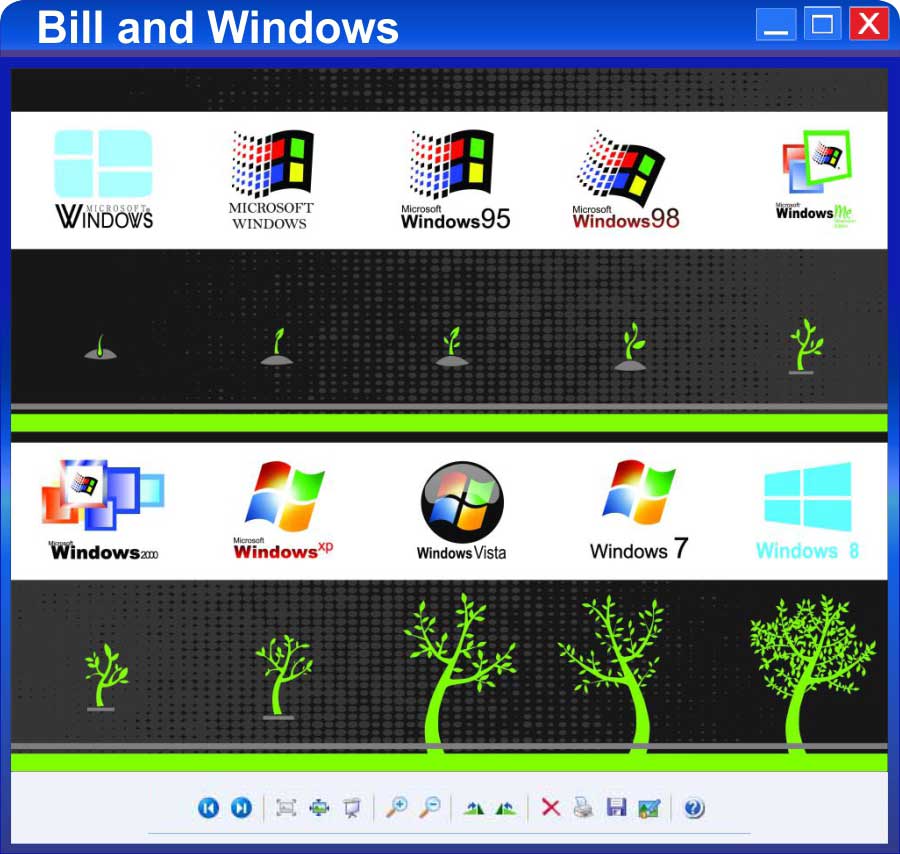
Bill and Windows

Microsoft had started working on Windows in the second half of 1982. If you look at the ‘Windows 1.0’ version, you can see that a user could open window screens through the MS-DOS prompt. Interestingly, even before the new operating system was named Windows, the code name for it was ‘Interface Manager’. However, the name Windows went well with the operating system as the user could work on and manage more than one window, without having to quit or restart the computer. Microsoft was to launch the Windows in 1983 but it took time to develop. Now that the GUI came along, you had Windows 1.0 with several programs, including MS-DOS file management, Paint, Windows Writer, Notepad, Calculator, Calendar, Card file and Clock to help you manage the day-to-day activities. It also had a game called ‘Reverse’ included in the package. This package was launched on November 20, 1985.
Following his illness, Paul Allen resigned in 1983 and Bill became the sole in-charge of the company. Bill would be rude, sarcastic and ruthless with his competitor. Even the people associated with Bill in the early days of his career, MITS owner, Ed Roberts did not have anything pleasant to mention about him. He often said that Bill was a spoilt rich kid. Some companies even refused to work with Microsoft because of Bill’s underhand ways of working. Bill also got involved in various legal disputes with Apple and his long-time partner IBM.
Do you know?
Bill was a rash car driver and would take high-speed nightmare drives and most of the times land up being fined for traffic violation. In one instance, Bill had forgotten his driver’s license and Paul Allen had to bail him out of jail.
The year 1985 saw the launching of Windows. It was also the year when the company’s sales reported the figure $140 million. With a proud product line up consisting of operating systems, business software, hardware and how-to books, the sales figure seemed to be more than obvious. In 1986, the company introduced Microsoft Works, which integrated word processing, spreadsheet, database, communications and drawing functions into a single program. The Microsoft growth graph was climbing up north and its next milestone came in the year 1986 when Microsoft’s shares were floated on the New York Stock Exchange. Around this time, Bill was 32 and proudly carried the tag of the world’s youngest ever billionaire.

personal life
For a computer geek like Bill, dating was a time consuming and energy draining task which he could not afford. The kind of dedication that Bill had for computer, he would hardly get time to socialise. However, in his personal life operating system, Bill installed and later uninstalled many programs (girlfriends) and it was only after he met Melinda French, a Microsoft employee at a press event in Manhattan, that Bill clicked on “START > CONTROL PANEL > ADD PROGRAM > MELINDA.”
Melinda French was the daughter of an aerospace engineer and had two brothers and one sister. She was born and brought up in Dallas, Texas. An Alumnus of Duke University in Durham, North Carolina, Melinda earned her bachelor’s degree in computer science and engineering in three years which ideally was a four year degree program. She made her resume more impressive with her master’s degree from Duke’s business school. She joined Microsoft as a business manager.
It can be said that Bill’s grandmother ‘Gam’ was responsible for the Bill-meet-Melinda moment. The story goes like this: When Gam passed away in 1987, Bill bought three and a half acres of land on the proximity of Hood Canal in her fond memory. He built up the place into a retreat spot for family gatherings and called it “Cheerio” meaning “Good-bye.” Bill’s family would visit this place for short vacation when Bill and his siblings were in school. Cheerio was a fine setting of three vacation homes, tennis courts and a spa. Bill had a dual-purpose in setting up this place, one being able to meet for family gatherings and second, to meet over for business retreat. His mother, Mary Gates, while talking about Cheerio quoted, “The idea was really a tribute to Gam, as she was the glue that kept our family together.”
The retreat spot soon became a site for the Micro games, an event especially for friends, family and Microsoft employees. At the event, the members of Gates family played host and judges while the guests got to have all the fun. Bill would plan for the event much ahead and would also play the host. The participants were divided into teams and were led into fun activities like solving puzzles, singing, treasure hunt and more. It was during the Micro games that Bill met Melinda. He found her attractive and they hit it right from the start. Around the same time Microsoft began working on the second version of Windows.

Windows 2.0
Microsoft released ‘Windows 2.0’ on December 9, 1987. It was designed for the Intel 286 processor and was a compendium of interesting features such as desktop icons and expanded memory. Its graphic support was better than the earlier version. In this version you could overlap windows, control the screen layout and use keyboard shortcuts to speed up your work. The “Control Panel” made its first appearance in this version 2.0.
With version 2.0, Microsoft introduced a new logo. Till 1987, Microsoft used the ‘Blibbet’ logo that was now replaced by the Microsoft ‘Pac-Man’ logo.
The 286 processor was followed by ‘Intel 386’. It had extended memory capabilities and supported Windows/386.The subsequent Windows release continued to improve speed, reliability and usability of the PC. The phenomenon of Windows was soon catching and now where once you could find windows, now you could also find Windows. It was finding great acceptance in business and personal segment.Bill had once said, “Microsoft was founded with a vision of a computer on every desk, and in every home. We've never wavered from that vision.” This vision was slowly turning into a reality.
When the world is using the products you have created and your sales are rocketing sky high across the financial year, where do you think you deserve to be? Some place in Greece or on an island along the Mediterranean coast? Well, before you can be anywhere else you get to be on to the list of billionaires. In 1987, ‘Forbes 400 Richest People in America’ listed Bill Gates amongst the richest people in America. Bill at that time was worth $1.25 billion when he debuted on the list. Well, that was just the beginning and if you go by the records, Bill occupied the number one position on the ‘Forbes 400 list’ from 1993 to 2007 and number one on “Forbes’ list of The World's Richest People” from 1995 to 2007 and then again in 2009.
On the other side of the window, Microsoft had begun to work on CD-ROMs (Compact Discs with Read-Only Memory). The compact discs were soon becoming popular among computer users. The reason behind the popularity of the disc was that it could hold more data as compared to the floppy diskettes and was more reliable. Software companies used these discs to distribute software, games and multimedia applications. Microsoft’s offering in this category was the first CD-ROM, ‘Microsoft Bookshelf’. The CD had a collection of ten popular and useful reference books on it. As technologies kept developing, Microsoft’s product line too went on expanding. In fact, based on the sales in 1988, Microsoft became the world’s largest software making company.
The visionary Bill Gates believed that as things were going digital, people someday would soon decorate their homes with digital artwork and there would be a great demand for digital images and videos. He founded a company called ‘Corbis’, the Latin for ‘wicker basket’ in 1989, with a vision that it would be the receptacle or the arsenal for visual media.

windows 3.0
In technology one thing holds true, you cannot afford to be on a page for long. This is one place where turning the page could also mean beginning of a new chapter. Please turn over. Date: 22 May, 1990, Microsoft launches Windows 3.0.
Compared to the earlier versions, Windows 3.0 was far better. The Intel 386 processor was a bundle of super-features, the 32 bit microprocessor could support advanced graphics with sixteen colours, had improved icons and was faster. The feature ‘Virtual Memory’ enhanced the visual graphics. The Windows 3.0 opened curtains to ‘Program Manager’, ‘File Manager’ and ‘Print Manager’. Windows was now been increasingly used at home and work. Some of the other added features were games like ‘Solitaire’, ‘Hearts’ and ‘Minesweeper’.
Windows 3.0 was shortly followed by Windows 3.1 in 1992. Taken together, Microsoft sold 10 million copies in the first two years, making it the most widely used Windows operating system. Like a book that is divided into parts, and parts into chapters, so can the upgrades at Microsoft be categorised.
The release of Windows NT on July 27, 1993, marked the beginning of another part in the books of Microsoft. The product line at Microsoft got bigger as the company also entered the online services and video games, besides computer software. For the first five years of Microsoft, Bill paid personal attention to every coding that was done, but later with the passage of time and increase in the number of technologies it became practically impossible.
Do you Know?
In March 1997, Adam Quinn Pletcher threatened to kill Bill Gates if he didn’t pay him $5 million. In case you are wondering what happened, then you would be glad to know that the FBI agents caught him and put him to trial.
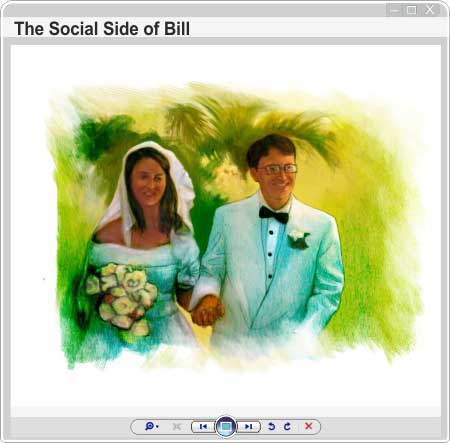

The Social Side of Bill
Bill Gates while talking about marriage in the book “The Making of Microsoft” by Daniel Ichbiah and Susan L Knepper said, “When I’m 35, I’ll get married.” He and Melinda dated for several years before they finally got engaged in 1993. Bill was 38 when he married Melinda on the New Year’s Day, 1st January, 1994. The marriage ceremony was a very hush- hush affair. They chose a privately owned place on the island of Lanai in Hawaii. No shutterbugs and no party crashers were allowed. The guest list had only 130 names on it. The date and venue of the event was kept undercover but then you can blame it on “Firewall failure,” reporters somehow landed there.
On the wedding day, dressed in a sparkling white gown Melinda walked down the aisle. Her trail was followed by her entourage of bridesmaid dressed in pink gown. Bill in a dashing dinner jacket was accompanied by his best man, Steve Ballmer who was handling the Finance and HR at Microsoft. The Roman Catholic ceremony was held on a cliff above the ocean.
If you thought geeks do not know what is being romantic then you surely might not have heard this. This was before Bill married Melinda. On a fine Sunday morning, Bill showed his romantic streak by flying Melinda to Omaha, Nebraska. He took her to his friend Warren Buffet’s jewellery store Borsheim. Buffet’s store which usually remained closed on Sundays was opened specially for his friend. Bill picked out a ring for Melinda and later married her on the New Year’s Day.
Life of the world’s richest man was no different from that of ours. It was a bag full of mixed emotions of life... joys, sorrows, highs and lows. Six months after the marriage, grief again came knocking on Bill’s door when his mother lost her battle against cancer. Bill was very close to his mother and the news of his mother’s death hit him real hard. The moment he heard about this, without wasting time, he got in his car and rushed to his parent’s residence. He was highly disturbed by the news and drove his car so fast that a traffic police officer made him halt and was just going to fine him for speeding when he realized the identity of the driver. What the cop saw kind of melted his heart. Tears were rolling down Bill’s face and he was explaining to the cop his reasons for speeding. It is strangely true, in John Lennon’s words, “Life happens when we are busy making other plans.”

Return to Work Front
Around mid-90s, say 1994, Internet was slowly spreading its web. Bill realized that the internet would soon become the most powerful tool mankind would ever use. Keeping in sync with the technological developments, Microsoft added “Hypertext Mark-up Language (HTML)” to its product line. HTML was created to build Web pages. Other companies were already making software for the Internet. It seemed like the buzzword then, the ‘INTERNET’. Now, how could Microsoft stay behind? So, it added a web browser – the ‘Internet Explorer’, to their newest Windows operating system. By now, the Microsoft spectrum was getting wider as it was into making software for network of computers and for creating websites with graphics, animation, video and audio. It was the time when Microsoft made everything and anything for the internet.
In 1995, Bill authored the book “The Road Ahead.” Written with the aid of Microsoft executive Nathan Myhrvold and journalist Peter Rinearson, the book potted what the personal computing revolution would be like and also spoke about the coming of a global information superhighway, faintly alluding to the internet.
windows 1995

The press release for Microsoft Windows 1995 went like this, “It’s here.” Yes, if you were at the launch event of Windows 95, on the 24th August, 1995 with Jay Leno and Bill Gates, you too would have gone exclaiming in a jaw dropping expression, “It is here!” It was the most powerful version of Windows – the ‘Windows 1995’. In those days, you would have found people using fax/modem, emails, multimedia games and educational software. The latest version of Microsoft’s OS was like an answer to convergence technology, almost an all-in-one technology product.
Windows 95 had a built-in Internet support, dial-up networking, and new “Plug and Play” feature which made installing hardware and software easy. The 32-bit operating system had some amazing features such as enhanced multimedia, more powerful options for mobile computing and integrated networking. Window 95 was surely going to change the way people did business. To run this OS, all that one required was a PC with a 386DX or preferably a 486 processor.
While Windows 95 was creating a buzz, Microsoft also launched its own online service – ‘Microsoft Network (MSN)’. The fascinating new look and features of Windows captured a lot of attention. ‘Start menu’ and ‘task bar’ options made computing seemingly effortless. With Windows 95 began the use of three small rectangle boxes, positioned on the top right hand end of a window, the icon – ‘minimize’, ‘maximise’ and ‘close’. [Click close].

At the Home Front
The first bundle of joy at Bill’s home came in the year 1996, who was named Jennifer Katharine. Bill Gates lived in a house located on the side of a hill overlooking Lake Washington in Medina. The plush 66,000 sq. ft. estate had a 60-foot swimming pool with an underground music system, a 2,500 sq. ft. gym and a 1,000 sq. ft. dining room. The house was named ‘Xanadu 2.0’ after the mansion in the movie “Citizen Kane”. The earth-sheltered mansion was designed in the Pacific lodge style, with classic features such as a large private library with a dome shaped roof and oculus. It also featured an estate-wide server system, and heated floors and driveways. One astounding feature of this house was that before any guest entered they were made to wear a pin so that on entering the room, the temperature, music and lights would adjust according to the guests’ preferences. The county records as of 2006 assessed the total value of the land and house to approx $125 million.
Do you know?
Xanadu had a parking space for twenty cars and a collection of Bill Gates’ sports cars hidden underground.
Bill Under the Weather - Anti-trust litigations

Even before the clouds of Anti-trust litigation could hit the Microsoft airs the ‘Federal Trade Commission’ (FTC) started keeping an eye on the activities of the software giant. After all, it was the FTC’s job to make sure that the companies were conducting their business legally. Here it seemed that Bill took his favourite childhood board game MONOPOLY almost literally. Microsoft insisted the computer makers who were selling Microsoft Operating System to also sell the other Microsoft products. The lawyers of the U.S. Department of Justice sued Microsoft for indulging in such business practices. A major blow came in June 2000, when the judge ruled that Microsoft should be split into two smaller businesses. Bill was not happy with this verdict and therefore he appealed against this decision.The European Union too found Microsoft guilty of carrying out unlawful monopolistic practices, in 2004.
Do you know?
Bill owns the 72-page collection of Leonardo da Vinci's scientific writings – Codex Leicester. The writings are a mixture of observations on water properties, astronomy and rocks and fossils. He puts the Codex on public display once a year in a different city around the world.
In a major move on the timeline of Microsoft, in 1998, bill Gates announced a new president for Microsoft Corporation. Steve Ballmer would be the man in-charge of the day-to-day work at Microsoft. In 1999, Bill Gates was blessed with a son, whom he named Rory John. It was also the time when he published his second book, “Business @ the Speed of Thought”. In this book, Bill discussed about how business and technology were integrated and how digital infrastructures and information networks would change the business dynamics. Now being a father of two kids changed Bill to a great extent. His reasons for staying up at night changed from looking out for bugs on a computer program to changing the diapers and caring for a crying baby. Despite of a busy schedule where he would spend twelve hours a day at work on weekdays and eight hours a day on weekends, he would find time to read. Bill’s favourite read included “The Great Gatsby” and “Catcher in the Rye.” Bill liked the former book so much that he got certain quotes engraved on the ceiling of his library.
Apart from reading, skiing and golf, Bill was crazy about fast cars. Right from his early years when he owned an orange red Mustang convertible to Porsche 930 Turbo, he has a fine collection of sports car. In his list of sports car, he had a Lexus and a Ferrari 348, later some Porsches including a Porsche 959 whose price tag was about one million dollars!!!
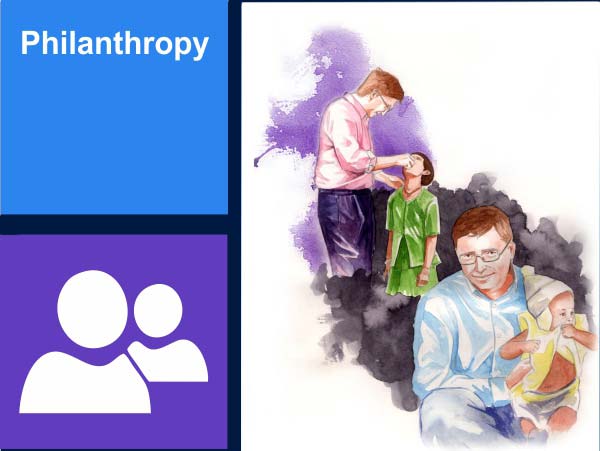
Philanthropy
On the first death anniversary of Bill’s mother, Mary Gates, Bill and Melinda made a special gift to honour her by donating $10 million to the University of Washington. The amount established the “Mary Gates Endowment for Students”. It was Mary Gates, his mother who had managed to pay for Bill’s computer fees through Lakeside Garage sales. As a mark of respect for the woman who had placed a high value on education, this donation was made. The purpose of this scholarship was to aid the education of the many talented and deserving undergraduate students. The Gates were known for supporting many charitable causes. The ‘Gates Library Foundation’ is one the several charitable works of Bill Gates. He donated $200 million to the foundation whose purpose is to provide computers and Internet access to public libraries in low-income areas of United States and Canada. The charitable works of Gates became more prominent with the foundation of the ‘Bill and Melinda Gates Foundation’.
Do You Know ?
In 2002, in a survey conducted by the City University of Hong Kong Bill, Bill was considered more idolized than the Chinese Communist leader Mao Tse-tung in a poll of teenagers in Hong Kong and China.
Before setting up the Bill Foundation, Bill studied the philanthropic works of ‘Andrew Carnegie’ and ‘John D. Rockefeller’, the pioneers of American industrial revolution. Bill and his dad met the Rockefeller several times to understand the process of giving away.
In the year 1999, the Gates founded the world’s largest charitable trust in the world. The foundation started out by a contribution of $28 billion. It mainly focused on activities ignored by the government and other organisations. The Foundation supported the research for cure of disease like malaria which kills millions of people in poor countries. It had a transparent system in place, which enabled the benefactors to have the exact information as to how their money was being spent. In one of the interviews, Bill said that he was working on mobile cash transaction wherein the entire transaction would become transparent. One of the best things about being Bill Gates is that you tend to have friends in high places. Bill got his friends businessman and investor ‘Warren Buffet’ and the CEO of ‘Facebook’, Mark Zuckerberg sign a promise which they called the “Bill-Buffet Giving Pledge,” according to which they agreed to donate at least half of their wealth to charity over the course of time.
After handing over the Microsoft baton to Steve Ballmer, Bill became more involved in the Foundation activities. One of the major donations was a $200 million to the Cambridge University in England to help students study science and technology. Even as Bill was busy with his contribution to the society, his works did not go unnoticed. In 1999, he was listed in the ‘Sunday Times Power List’ and in 2001, he figured on ‘The Guardian’s ‘Top 100 influential people in media’. The ‘TIME’ magazine, in 2005 collectively named Bill, his wife and U2’s lead singer Bono as the “Persons of the Year” for their humanitarian efforts.
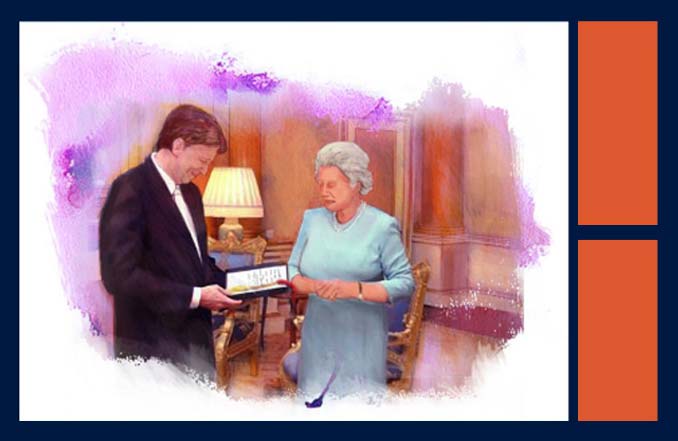
In 2004, Bill got on board of directors in his friend Warren Buffet’s investment company Berkshire Hathaway. While recognition was coming in from all quarters, the Bill family was expecting a new member. Much before Queen Elizabeth II honoured Bill Gates with “HonoraryKnight Commander of the Order of the British Empire” (KBE) in 2005, the Gates’ had a new princess in the family and they named her ‘Phoebe Adele’. On the market front, Microsoft was riding on cloud nine with its latest offering, ‘Windows XP’.
When Bill is not wearing the ‘Sultan-of-Software’ hat, he is ‘Bill the humanitarian’. Bill was deeply moved when he visited Africa and after seeing the poor children in state of starvation and sickness, he realized that there were more solutions he had to work on. This episode changed Bill’s perceptions and helped him re-align his mission. He also realized that more than money, it was his time that the cause needed from him. Thus, in 2006, he announced that he would be making a transition in his working pattern, from working for Microsoft to devoting more quality time to the Foundation. At this point of transition, Bill’s salary was $616,667 and bonus $350,000 which summed up to $966,667.
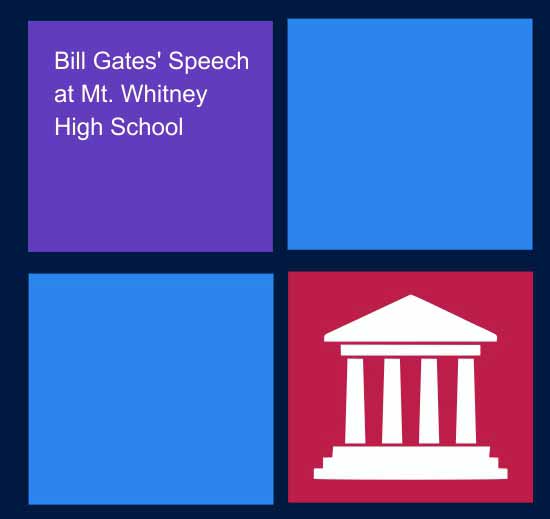
Bill Gates' Speech at Mt. Whitney High School
Among the popular speeches that Bill has made, there is this speech that he gave at a High School in California in which he spoke about eleven things that the students could not learn in school. His rules may sound into-your-face, but are ironically true. He makes no use of sugar-coated words and rather speaks of the stark realities that exist outside the school world.
Rule 1: Life is not fair — get used to it!
Rule 2: The world won't care about your self-esteem. The world will expect you to accomplish something BEFORE you feel good about yourself.
Rule 3: You will NOT make $60,000 a year right out of high school. You won't be a vice-president with a car and phone until you earn both.
Rule 4: If you think your teacher is tough, wait till you get a boss.
Rule 5: Flipping burgers is not beneath your dignity. Your Grandparents had a different word for burger flipping — they called it OPPORTUNITY.
Rule 6: If you mess up, it's not your parents' fault, so don't whine about your mistakes, learn from them.
Rule 7: Before you were born, your parents weren't as boring as they are now. They got that way from paying your bills, cleaning your clothes and listening to you talk about how cool you thought you are. So before you save the rain forest from the parasites of your parent's generation, try delousing the closet in your own room.
Rule 8: Your school may have done away with winners and losers, but life HAS NOT. In some schools they have abolished failing grades and they'll give you as MANY TIMES as you want to get the right answer. This doesn't bear the slightest resemblance to ANYTHING in real life.
Rule 9: Life is not divided into semesters. You don't get summers off and very few employers are interested in helping you FIND YOURSELF. Do that on your own time.
Rule 10: Television is NOT real life. In real life people actually have to leave the coffee shop and go to jobs.
Rule 11: Be nice to nerds. Chances are you'll end up working for one.
So those were the pearls of wisdom coming from Bill Gates. You surely would agree with him. Today, Bill Gates is more involved in global development and health issues in the under developed and developing countries. On his wedding day, his mother gave him a note which said, “to those much is given, much is expected”.
Start > Shutdown
Start > Shutdown
It is through the works of the Gates Foundation that they are working on eradicating polio, fighting against malaria, providing maternity facilities for women, solutions to the problems in agriculture, building wells, and many such issues that need attention. They plan to eventually give 95% of their wealth to charity. Andrew Carnegie once said, “The man who dies rich, dies disgraced”. In case of Bill Gates it can be said that with contribution like his, he surely has made a place for himself among the world’s most influential people of our times. It was Bill Gates who rebooted the working culture of the last two decades and has changed the way we store, manage, exchange and secure our data, through his ‘Windows’.
After learning about Bill Gates, I had these words pop-up in my mind – LIFE, SUCCESS, SINGLE, and WINDOW. And they are best lined up meaningfully by F. Scott Fitzgerald an American author as, “Life is much more successfully looked at from a single window.”


Biography of Bill Gates | 7 Comments >>
7 --Comments
thanks for giving the detailed knowledge... got to know a lot of vital information
Billu Boy we love u...
I know Bill Gates as a philanthropist.... nice site
This is a interesting post by the way. I am going to go ahead and bookmark this article for my sister to read later on tomorrow. Keep up the excellent work.
I want going to comment as this posts a bit old now, but just wanted to say thanks.
My relatives every time say that I am wasting my time here at web, but I know I am getting familiarity everyday by reading thes good content.
Thanks so much for this great Articles
Leave Comment.
Your email address will not be published. Required fields are marked.
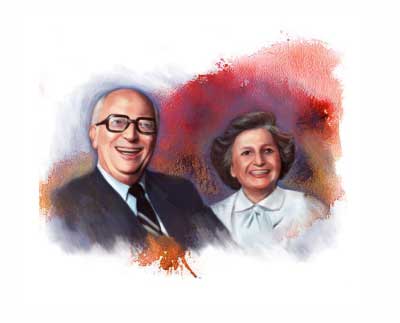
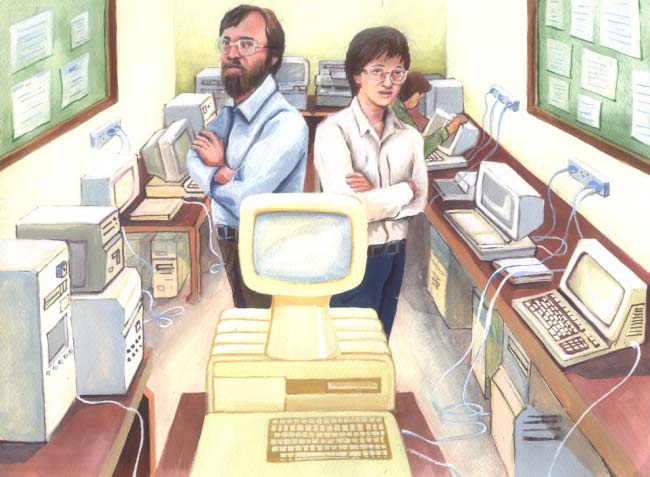
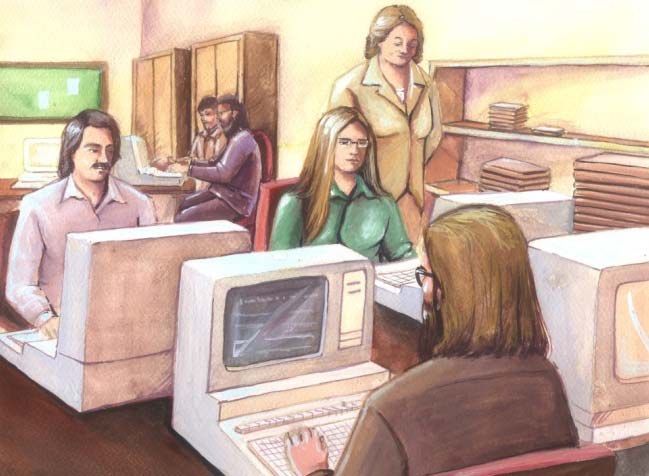
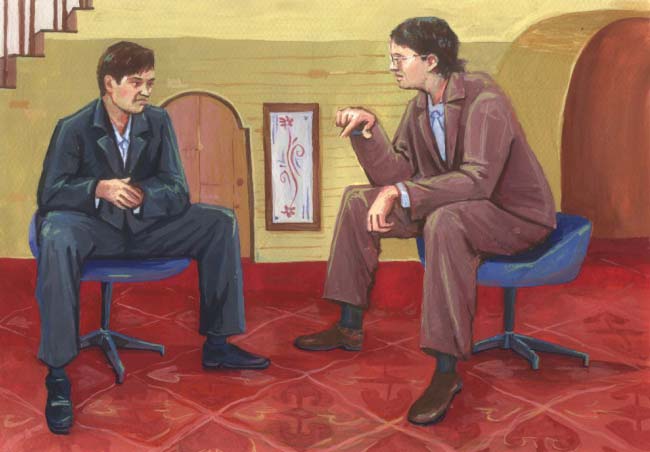
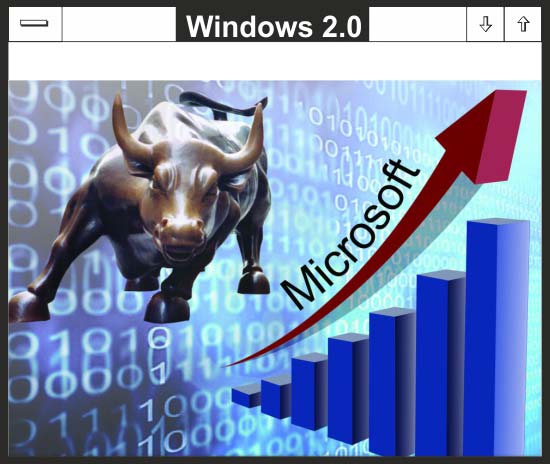
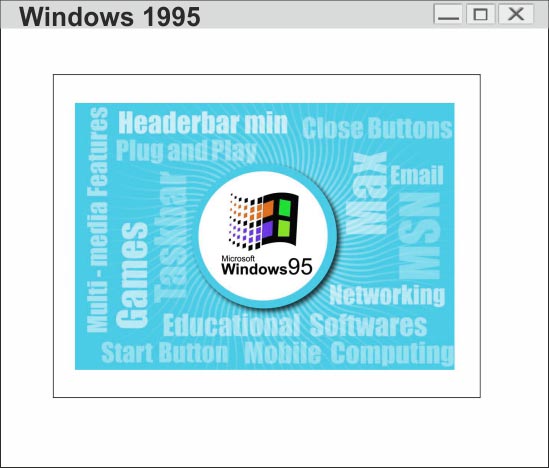
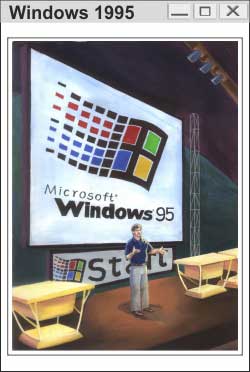
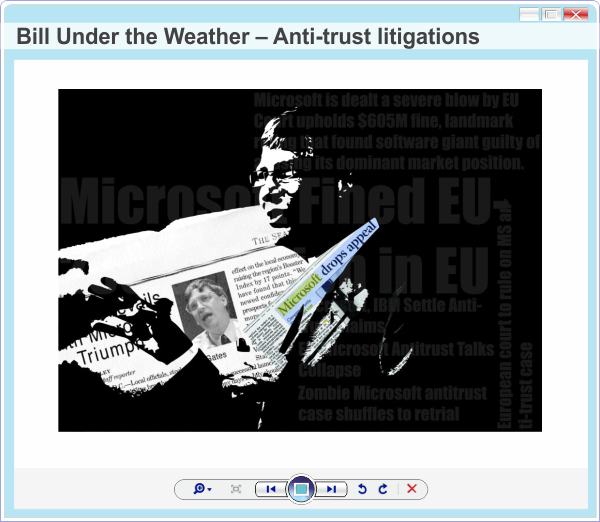
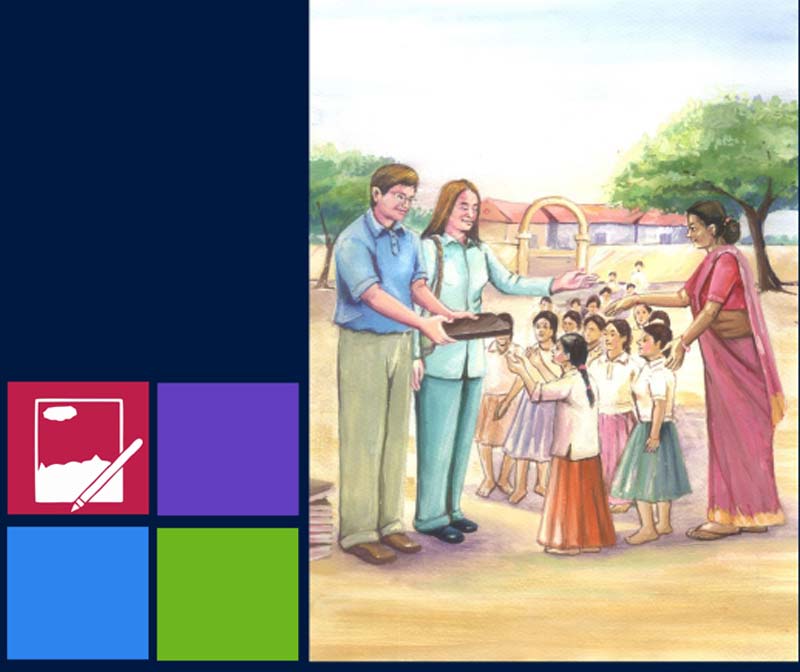


Bill gates should have focused on working and innovating with microsoft and had not to handover the administration to Steve Ballmer. and do charity....